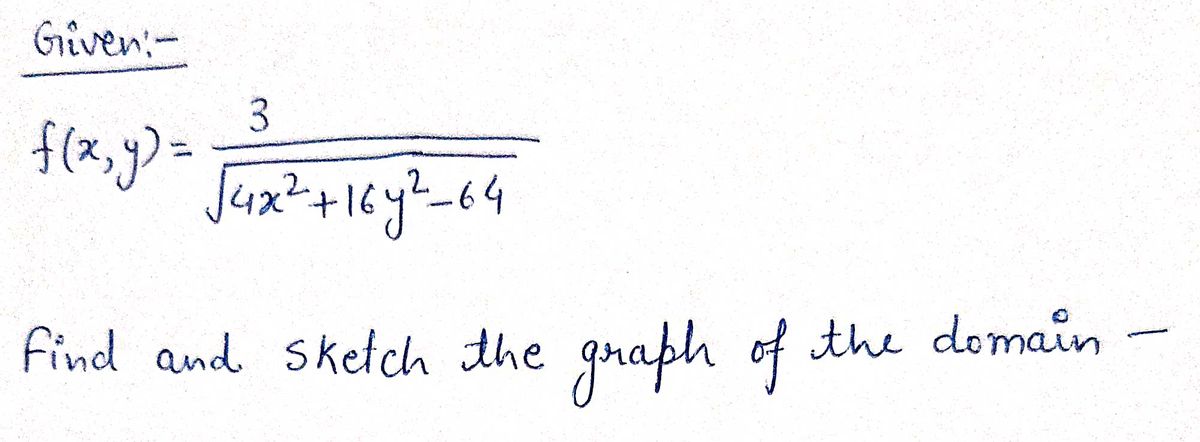Calculus: Early Transcendentals
8th Edition
ISBN:9781285741550
Author:James Stewart
Publisher:James Stewart
Chapter1: Functions And Models
Section: Chapter Questions
Problem 1RCC: (a) What is a function? What are its domain and range? (b) What is the graph of a function? (c) How...
Related questions
Question
100%
![**Problem 2:**
Find and sketch the graph of the domain of \( f(x, y) = \frac{3}{\sqrt{4x^2 + 16y^2 - 64}} \).
**Explanation:**
To determine the domain of the function \( f(x, y) \), we need to ensure that the expression under the square root is positive, i.e.,
\[ 4x^2 + 16y^2 - 64 > 0. \]
This inequality represents the region where the function is defined. Solving for the boundary of this inequality:
1. Simplify the equation:
\[ 4x^2 + 16y^2 = 64. \]
2. Divide the whole equation by 64:
\[ \frac{x^2}{16} + \frac{y^2}{4} = 1. \]
This is the equation of an ellipse centered at the origin with semi-major axis along the x-axis of length 4 and semi-minor axis along the y-axis of length 2.
**Graph Explanation:**
The domain is the region outside of this ellipse. When sketching:
- Draw the ellipse centered at the origin.
- The semi-major axis is 4 units along the x-axis, and the semi-minor axis is 2 units along the y-axis.
- The domain of \( f(x, y) \) is the area outside this ellipse.](/v2/_next/image?url=https%3A%2F%2Fcontent.bartleby.com%2Fqna-images%2Fquestion%2Faff7206f-9910-4eba-9e78-ffe8dd60a76e%2F30882305-3b4c-41f5-8b81-5eb7fdaa310d%2Fz17o1zv_processed.png&w=3840&q=75)
Transcribed Image Text:**Problem 2:**
Find and sketch the graph of the domain of \( f(x, y) = \frac{3}{\sqrt{4x^2 + 16y^2 - 64}} \).
**Explanation:**
To determine the domain of the function \( f(x, y) \), we need to ensure that the expression under the square root is positive, i.e.,
\[ 4x^2 + 16y^2 - 64 > 0. \]
This inequality represents the region where the function is defined. Solving for the boundary of this inequality:
1. Simplify the equation:
\[ 4x^2 + 16y^2 = 64. \]
2. Divide the whole equation by 64:
\[ \frac{x^2}{16} + \frac{y^2}{4} = 1. \]
This is the equation of an ellipse centered at the origin with semi-major axis along the x-axis of length 4 and semi-minor axis along the y-axis of length 2.
**Graph Explanation:**
The domain is the region outside of this ellipse. When sketching:
- Draw the ellipse centered at the origin.
- The semi-major axis is 4 units along the x-axis, and the semi-minor axis is 2 units along the y-axis.
- The domain of \( f(x, y) \) is the area outside this ellipse.
Expert Solution
Step 1

Step by step
Solved in 3 steps with 3 images

Recommended textbooks for you

Calculus: Early Transcendentals
Calculus
ISBN:
9781285741550
Author:
James Stewart
Publisher:
Cengage Learning

Thomas' Calculus (14th Edition)
Calculus
ISBN:
9780134438986
Author:
Joel R. Hass, Christopher E. Heil, Maurice D. Weir
Publisher:
PEARSON

Calculus: Early Transcendentals (3rd Edition)
Calculus
ISBN:
9780134763644
Author:
William L. Briggs, Lyle Cochran, Bernard Gillett, Eric Schulz
Publisher:
PEARSON

Calculus: Early Transcendentals
Calculus
ISBN:
9781285741550
Author:
James Stewart
Publisher:
Cengage Learning

Thomas' Calculus (14th Edition)
Calculus
ISBN:
9780134438986
Author:
Joel R. Hass, Christopher E. Heil, Maurice D. Weir
Publisher:
PEARSON

Calculus: Early Transcendentals (3rd Edition)
Calculus
ISBN:
9780134763644
Author:
William L. Briggs, Lyle Cochran, Bernard Gillett, Eric Schulz
Publisher:
PEARSON

Calculus: Early Transcendentals
Calculus
ISBN:
9781319050740
Author:
Jon Rogawski, Colin Adams, Robert Franzosa
Publisher:
W. H. Freeman


Calculus: Early Transcendental Functions
Calculus
ISBN:
9781337552516
Author:
Ron Larson, Bruce H. Edwards
Publisher:
Cengage Learning